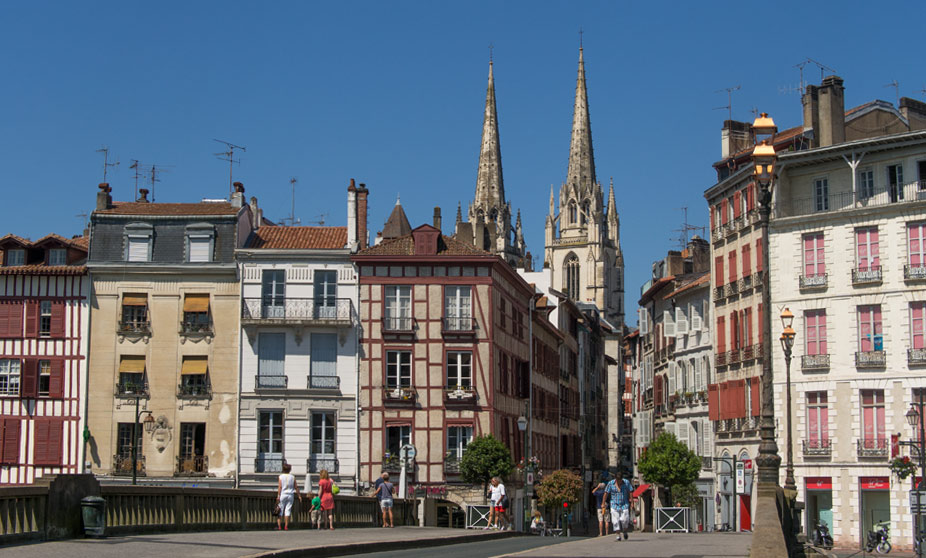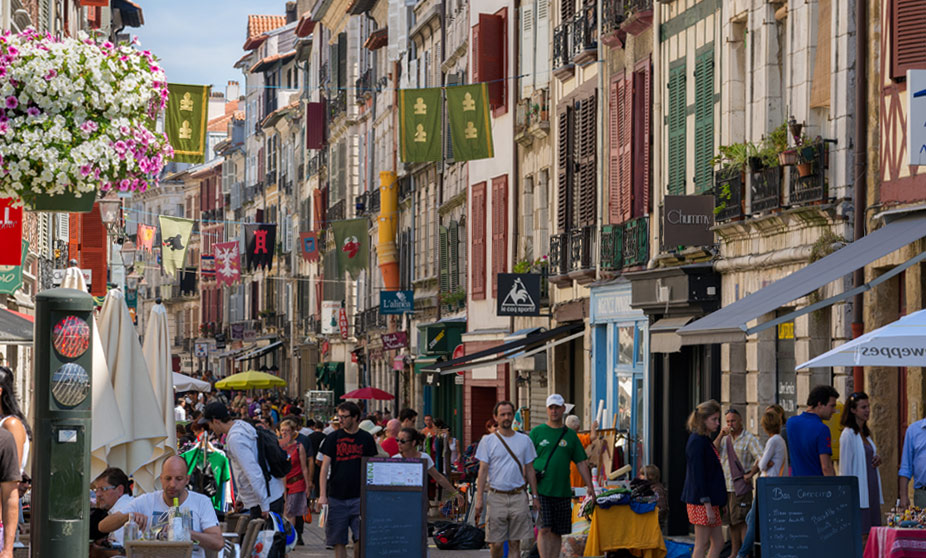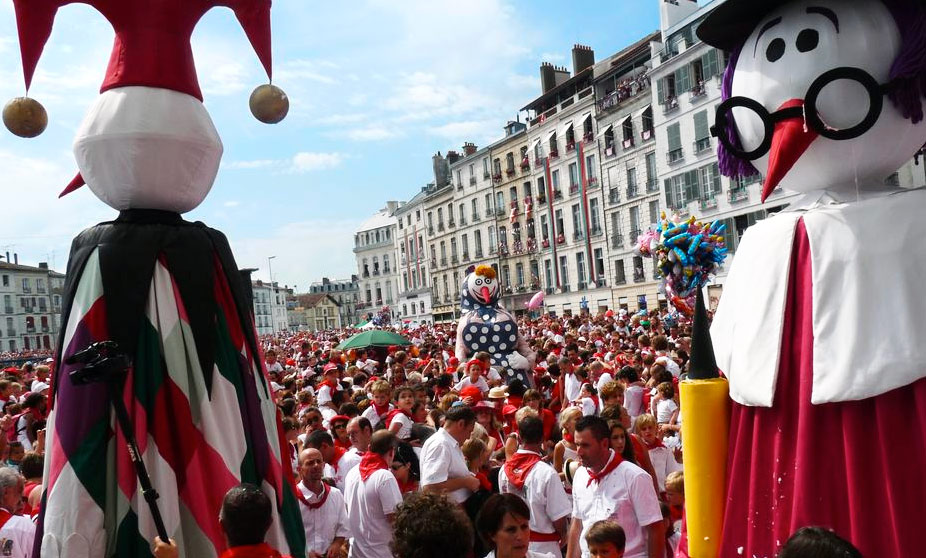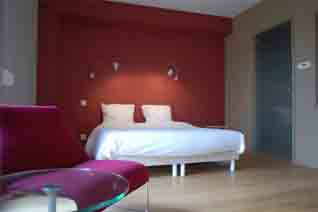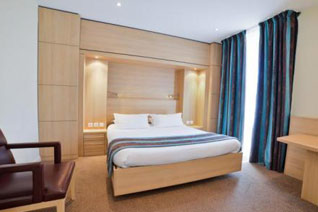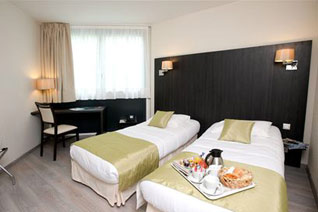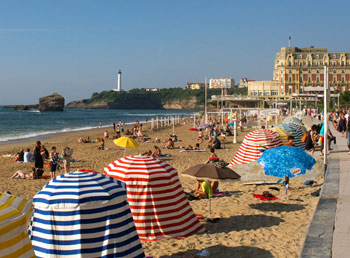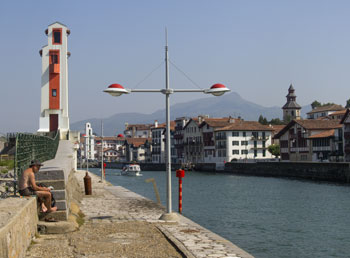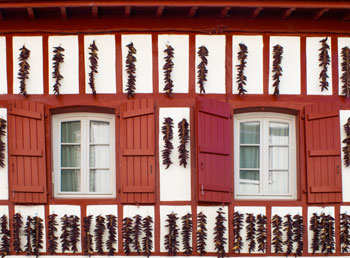Grand Bayonne
Grand Bayonne is the more commercial part of town but also the ancient heart. There, you will find the ![]() Sainte Marie Cathedral, which dominates the city’s skyline.
Sainte Marie Cathedral, which dominates the city’s skyline.
The construction of this gothic cathedral started in 1213 and wasn’t finished until the 17th century (with exception of the north tower, finished in the 19th century). Alongside the cathedral is the cloister, which dates back to 1240 and features a flamboyant gothic style. The cloister is one of the largest in all of France.
Not far from the cathedral, you will find the ![]() Château-Vieux (“Old Castle”). Built in the 12th century by the Viscounts of Labourd, this was originally the official residence of the governors of the city (including Edward, the black prince). Today it still belongs to the military and is therefore not open to the public.
Château-Vieux (“Old Castle”). Built in the 12th century by the Viscounts of Labourd, this was originally the official residence of the governors of the city (including Edward, the black prince). Today it still belongs to the military and is therefore not open to the public.
The impressive ![]() Town Hall of Bayonne (“La Mairie” or “L’Hôtel de Ville” in French) is located at the intersection of the Nive and Adour Rivers. It was built in 1843 in neoclassical style and was originally home to the customs office. The six statues in the roof represent the economic and artistic activities of the city.
Town Hall of Bayonne (“La Mairie” or “L’Hôtel de Ville” in French) is located at the intersection of the Nive and Adour Rivers. It was built in 1843 in neoclassical style and was originally home to the customs office. The six statues in the roof represent the economic and artistic activities of the city.
Today, apart from the town hall, the building also houses a theater and a café with a nice terrace in the square in front of the building.
By the Nive River you will find the covered market of Bayonne called ![]() “Les Halles”. This is the perfect place for discovering all the local produce that Bayonne has to offer. You will find meat, fish and a couple of bakeries, where you can try the tasty gâteau Basque (“Basque cake”).
“Les Halles”. This is the perfect place for discovering all the local produce that Bayonne has to offer. You will find meat, fish and a couple of bakeries, where you can try the tasty gâteau Basque (“Basque cake”).
The market and its surroundings are especially busy on Saturday mornings, when local producers and clothing traders gather there for an open-air market.
Bayonne also has a botanical garden, called ![]() Jardin Botanique, which occupies an extension of 3000 m2 and is located at the Avenue du 11 Novembre (next to the tourism office). It was opened in the late 1990s and it stands on top of a bastion between the cathedral and the ramparts.
Jardin Botanique, which occupies an extension of 3000 m2 and is located at the Avenue du 11 Novembre (next to the tourism office). It was opened in the late 1990s and it stands on top of a bastion between the cathedral and the ramparts.
Petit Bayonne
Apart from wandering through the streets of this beautiful neighborhood and enjoying its architecture, in Petit Bayonne, you can visit the ![]() Basque Museum (Musée basque et de l’histoire de Bayonne).
Basque Museum (Musée basque et de l’histoire de Bayonne).
Founded in 1922, it contains a nice collection of Basque and local French history. It is located in a small palace from the 16th century called “maison Dagourette.”
Another interesting museum located in this same neighborhood is the ![]() Bonnat Museum. It is named after the local realist painter, Léon Bonnat, whose own work makes up most of the main collection. There are however, other paintings from famous artists such as Botticelly, Rafael and Rembrandt. Due to renovations, the museum closed in April 2011. Its reopening date is unknown.
Bonnat Museum. It is named after the local realist painter, Léon Bonnat, whose own work makes up most of the main collection. There are however, other paintings from famous artists such as Botticelly, Rafael and Rembrandt. Due to renovations, the museum closed in April 2011. Its reopening date is unknown.
Sitting in the highest point of Petit Bayonne you will find the ![]() Château-Neuf (“new castle”) built in the 15th century by Charles IV. This massive building now belongs to the university and is unfortunately closed to the public.
Château-Neuf (“new castle”) built in the 15th century by Charles IV. This massive building now belongs to the university and is unfortunately closed to the public.
Saint-Esprit
From Petit Bayonne, it is possible to cross the Adour River via the Pont Saint-Esprit to the neighborhood of Saint-Esprit, where the ![]() citadel and
citadel and ![]() train station are located.
train station are located.
This neighborhood was originally part of Gascony and therefore different from the rest of Bayonne. It was settled primarily by Jews that had escaped from the Spanish Inquisition during the beginning of the 17th century. The Jews contributed much to Bayonne’s growth.
One of the most important of these contributions was the introduction of Chocolate. It first gained its foothold in Bayonne and then later spread to the rest of France. Today, there are still many chocolatiers found in the city, such as the ![]() L'Atelier du Chocolat which has a workshop on the far end of Saint-Esprit that can be visited. For more information, see the section below about “Local Products.”
L'Atelier du Chocolat which has a workshop on the far end of Saint-Esprit that can be visited. For more information, see the section below about “Local Products.”
In the 17th century, Vauban, who was the chief military engineer under Louis XIV, ordered the construction of the citadel and further fortifications. The citadel is a large square with four bastions. While still intact today, it belongs to the French Army and is not open to the public. It can be best viewed from the bridge called Pont Saint-Esprit.
Fetes de Bayonne & Bullfighting
Bayonne is well known for having one of the longest traditions of bull fighting in France. The bull fighting season runs from July to September with the biggest events taking place during the city’s local festival, called the Fêtes de Bayonne. Fêtes de Bayonne is the French version of Pamplona’s San Fermin (think Running of the Bulls and Hemingway) and attracts more then one million visitors annually, making it the largest festival in all of France.

